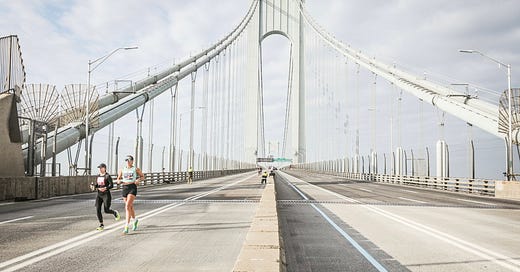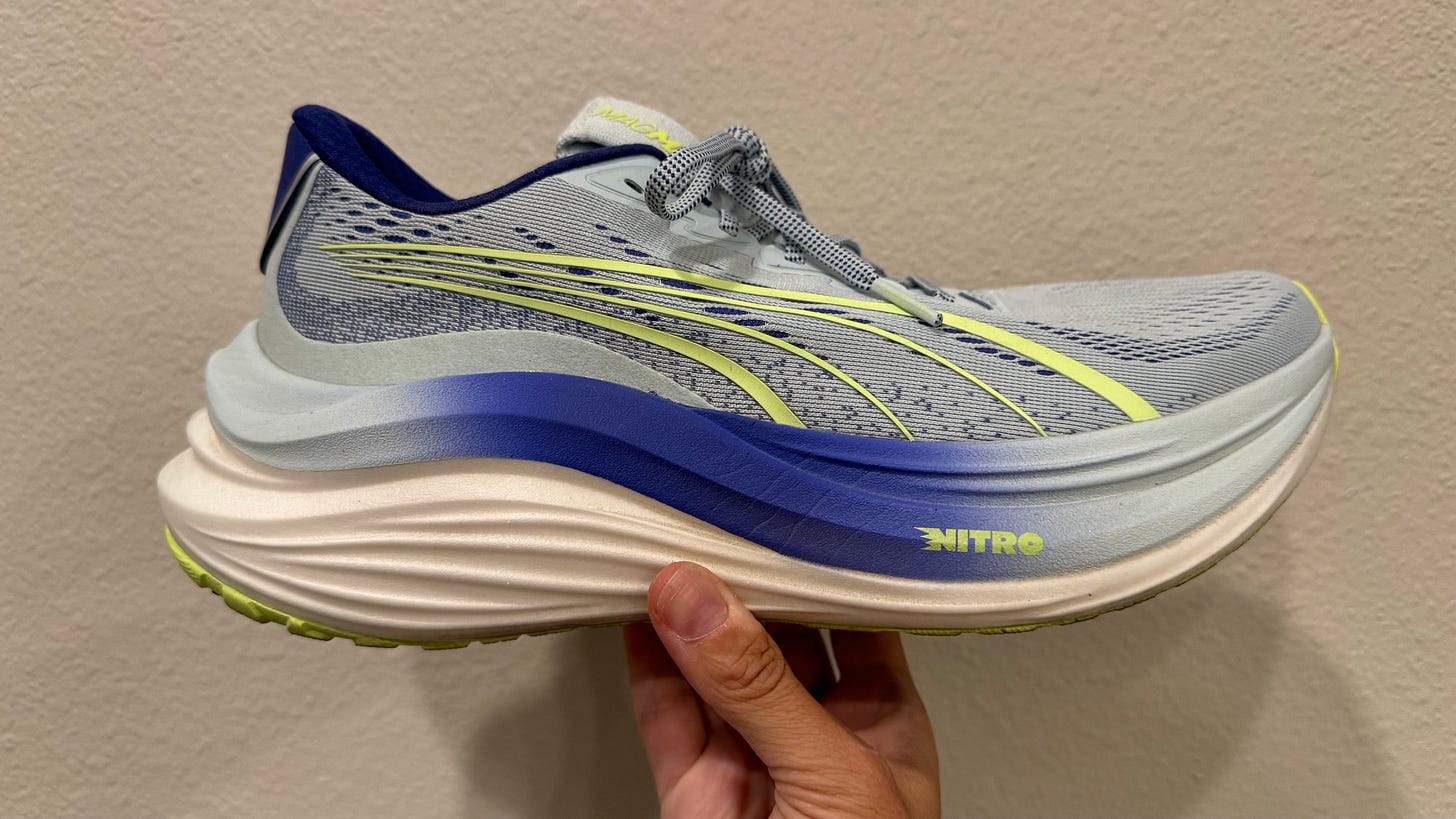It’s Actually OK to Not Run a Marathon
Despite what social media might have you believe, not *every* runner is a marathoner.
It’s officially September, which means marathon season is in full swing. There are 26 days until the Berlin Marathon, 40 days until the Chicago Marathon, and 61 days until the New York City Marathon—and #runtok, #runstagram and every social media platform (I’m sure there’s a LinkedIn post extolling the “what marathon training taught me about B2B SaaS sales” out there…) won’t let you forget it.
It’s also the time of year when I hear from runners who confess that they don’t feel like a “real” runner because they haven’t run a marathon. Let’s put that myth to bed.
You have to remember that the running community you see on social media is merely a snapshot of a part of what’s happening IRL. Industry estimates suggest that there are approximately 50 million runners in America right now. But only about 1.1 million runners complete a marathon each year, which is roughly 0.01 percent of the world's population, according to a 2019 report from the International Institute for Race Medicine (that number is likely a bit higher in the post-Covid-19 running boom—but it certainly hasn’t increased by 49 million).
In fact, most runners and walkers participated in 1-mile, 2-mile, 5K, 4-mile, 8K, 5-mile, or 10K distances, according to Running USA’s 2023 Race Trends (these shorter races are less time-consuming to train for while still offering a good challenge, survey respondents said). Only 10 percent of the runners surveyed across the world had participated in a marathon. Even fitness tracking platform Strava—which, from a statistics perspective, tends to draw a faster, more dedicated subset of runners—found that only five percent of runners on the app ran a 26.2-mile race in 2023, according to their Year In Sport report. And that was a 20 percent increase from 2022.
All of that is to say that the percentage of runners actually completing marathons is pretty small—even if it doesn’t come across that way on social media. The Instagram hashtag #marathon has 14,159,099 posts and counting, while #marathontraining has nearly 8 million; #marathoner has 1,594,236 posts and #marathonrunner has 1,251,425 posts. No wonder it’s so easy to get caught up in the social media-fication of running, where it seems like everyone’s running not just running marathons, but sharing their running routes, their speed workouts, their fueling strategies, and their best training tips with a “if I can do it, so can you!” angle. (Let’s just ignore the tiny subset of runners who post about doing a marathon without any training—that’s engagement bait and it serves no one, least of all the people doing it.)
Something else to remember: Today’s average finish time for the marathon is 4:32:49, which works out to an average 10:24 per mile, according to a study conducted by Run Repeat that included 19,614,975 marathon results from more than 32,335 races across the globe between 2008 to 2018. All the Boston Marathon qualifiers, the sub-3:00:00 marathoners—they are the exception. There are significantly more runners on the back end of the marathon finishing time bell curve (and crossing the finish line in six-plus hours is just as valid).
I’m a firm believer that anyone is capable of running a marathon with enough time and the right training, but, to me, the marathon has always been less about physical capability and more about having the desire to do it. Running 26.2 miles is a monumental effort, one that requires months to prepare for—physically and mentally—and one that shouldn’t be taken lightly. It’s an even more daunting distance to train for when you’re also juggling work and life responsibilities. If you don’t have a good “why” behind your decision to train, something that goes much deeper than “because everyone else is doing it,” it’s going to be really hard to do the work that’s necessary to get yourself across that finish line.
Social media is a highlight reel, and it’s wild to me how casually some people treat running 26.2 miles. Yes, I’ve run a lot of marathons. But I’ve never approached one without a little bit of healthy anxiety. I wish people talked a little more about how nerve-wracking just thinking about covering that distance can be, and how much they have to shift their normal life around to fit in the training necessary to complete it without feeling like total garbage.
And I want people to know that it’s OK to not want to undertake such a huge physical feat! It’s OK to have zero interest in waking up at the crack of dawn for track workouts and long runs. It’s OK to not want to train through the hottest days of summer. It’s OK to just want to run for the sake of running. (It’s also OK to defer or drop out of a race because you don’t want a persistent niggle or injury to get worse, or because your training isn’t where you’d like it to be before race day—but that’s another story.)
Training for nothing—or for life, to quote Des Linden—is just as valid as training for a marathon. Running isn’t about completing a specific distance, or doing that in a certain amount of time. Any race length can be as challenging as you want it to be. Maybe you don’t even want to race at all! There’s so much more to running than racing—maybe you want to be able to explore far-flung trails on your own two feet, maybe you just want to find a community of people who enjoy staying active, or maybe you just want some time to yourself where you’re free from a screen.
The only thing that makes you a “real” runner is participating in the act of running. That’s it. That’s the sport. If what you see on social media inspires you to tackle the marathon distance, that’s awesome. But don’t let yourself get pressured into something that can be a huge time suck and a physical and mental roller coaster just because it seems like that’s what everyone else is doing.
the rundown
PUMA MagMax
What shoe company isn’t in their maximally cushioned era at this point? Puma has officially entered the chat with the brand-new, $180 MagMax. I’m interpreting the name to mean this is a maximalized version of the Magnify, the brand’s versatile daily trainer. The MagMax is much beefier, with 46-millimeters of supercritical Nitro foam under the heel, which makes it ideal for long and recovery runs. I sometimes find these towering super trainers to be a little too firm, but this one had a nice softness to it; it’s not overly squishy, but you can definitely feel the foam compressing and bouncing back with each step. They’re also nice and stable, with a wide base to ensure your footing and PWRTape reinforcements that add extra support and structure. I wore this multiple times while my legs were recovering from Hood to Coast, and really enjoyed the ride.
Fasted Training Is Associated With Bone Injuries
I wish that fasting would burn itself out as a diet fad already. I’ve written about how unhelpful it can be for runners in the past, and a new study in the European Journal of Sport Science just confirmed that the incidence of bone injuries was 1.61 times higher in elite endurance athletes who currently used fasted training compared to those who have never used it or used it in the past. It kind of blew my mind that 28 percent of athletes in the study reported use of reduced carb intake and 38 percent of athletes reported use of fasted training—but with that in mind, it was less surprising to find that the incidence of bone injuries in the study was 44 percent. Carbs are fuel! Our bodies need fuel to perform! I promise you’re going to run better if you eat enough.
We Mind the Gap: The Gender Imbalance Amongst Sports Photographers
I know some pretty incredible sports photographers. The one thing most of them have in common? They’re men. It’s actually startling to realize how few women I know who’ve made a career out of sports photography—which is why I loved this piece for Glorious, in which outdoor sports photographer and producer Hannah Bailey traveled to Paris to delve into the issue. She found that at the Paris Olympics, only 22 percent of the accredited photographers there were female—a pretty bleak statistic, considering this was the first Olympics in history to have full gender parity on the playing field. As Bailey points out, an imbalance in photography teams can have implications for how sports and athletes are portrayed, what stories are told, and which perspectives are represented in Olympic coverage. While sharing her own experiences documenting skateboarding, Bailey also opines on how we might close this gender gap.
Omnium Cooling Headband
You probably saw Eliud Kipchoge and Sifan Hassan wearing the super stylish, $204 Omnius cooling headband like crowns at the Olympics. Did I look as good in it during my latest long run? Don’t answer that. This device uses cooling pieces made from a “highly thermally conductive graphite with a hydrophilic coating that optimizes the uptake and evaporation of the water” to increase the evaporative surface area of your skin, which amplifies the body's natural cooling mechanism. You have to soak the pieces before wear, and keep them wet while you run in order to optimize the cooling tech. I first tested it during an 18-mile run where the temperature fluctuated between 59°F and 75°F, which may not have been hot enough to get the full effect—although I felt noticeably less sweaty at the finish. I’m going to need to use this in worse conditions to get a better sense of whether it’s worth the price.








I think this stems from all of the hype for the Big Marathons. I can remember when certain road races were more celebrated. Peachtree 10k, Bolder Boulder, etc.
Love the Puma MagMax Nitro. Approaching Superblast 2 level good.